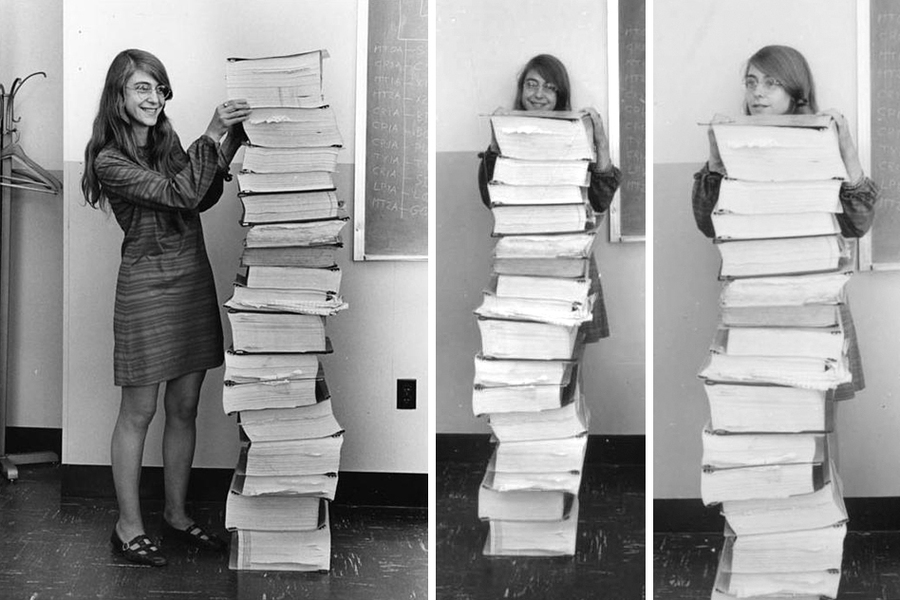The scientist who worked on humanity's journey to the moon: Who is Margaret Hamilton?
It is known to everyone that the Apollo astronauts were the pioneers of space travel, but the team that prepared the Apollo software was also one of the pioneers of the software field. Hamilton made a great contribution to software engineering becoming a discipline.

Born in 1936, Margaret Hamilton is a scientist who graduated from the mathematics department and a minor in philosophy at the University of Michigan. She says that she started majoring in philosophy under the influence of her father, who was a philosopher, and her grandfather, who was a writer. Hamilton talks about a professor who influenced her while she was studying at the university. She says that she was one of her favorite professors in the mathematics department and that she was the only female professor in the department.
At that time, she wanted to specialize in abstract mathematics and become a professor after graduation, but around 1963-1964, she heard that MIT had received a project from NASA and that people would be sent to the moon, and she thought that this was the opportunity of a lifetime. Within a few hours, she arranged to meet with two different project managers at MIT, and after the meeting, they both offered to work together on the same day. At this point, Hamilton decided who she would work with by flipping a coin so as not to offend anyone. Thus, Hamilton begins working on humanity's journey to the moon.
Margaret Elaine Hamilton (born August 17, 1936) is an American computer scientist, systems engineer, and business owner. She was director of the Software Engineering Division of the MIT Instrumentation Laboratory, which developed on-board flight software for NASA's Apollo program. She later founded two software companies—Higher Order Software in 1976 and Hamilton Technologies in 1986, both in Cambridge, Massachusetts.
It is known to everyone that the Apollo astronauts were the pioneers of space travel, but the team that prepared the Apollo software was also one of the pioneers of the software field. “We had no choice but to lead,” says Hamilton. In this period, disciplines such as software engineering and computer science did not exist. Hamilton, like others, learned several programming languages through her own efforts while working with a professor at MIT in 1959, and thus entered the field of software. Since Hamilton was new to one of the unmanned missions, they had her write the program that should run in case the mission was canceled. In short, a program that was never planned to work. But then the mission had to be canceled. “They called me right away because I had all the answers at that point,” Hamilton says. Thanks to her success in the project, Hamilton soon became the manager of the software team of 400 people.
After separating from her husband, Hamilton came to work with her daughter Lauren. One day, while her daughter Lauren was playing with the simulation, she ran two programs at the same time, and since the computer was not powerful enough to run more than one program, all the data of the previous program was deleted. Hamilton thinks what if this happens during the flight and goes to talk to her superiors. They tell Hamilton that the astronauts will not make such a mistake because they are well-trained. But on the Apollo 8 mission, Jim Lorell made the same mistake during the flight and lost all navigation information. Hamilton, on the other hand, has to work 9 hours overtime to reload the information.
Hamilton's most famous achievement during the Apollo mission was the computer-connected lights she called the priority display. These lights were designed to warn astronauts when something should not happen, such as when the computer was overloaded before the computer shuts itself down. Many people at NASA saw this as unnecessary work because they thought astronauts wouldn't make mistakes. But with Hamilton's insistence, priority indicators were made. As Aldrin left the radar on while approaching the moon landing, the computer was making unnecessary calculations and was overloaded. After the priority indicators came on, the astronauts realized there was a problem and restarted the computer before landing, and they were able to land without any problems.
Hamilton always wanted to be treated with the same respect as the engineers working with the hardware, and she finally got it. Hamilton made a great contribution to software engineering becoming a discipline. In fact, she is one of the people who coined this term. Hamilton also played a big role in ensuring that people working in the field of software receive the same respect as engineers dealing with hardware. Today, Hamilton is 87 years old and the founder of Hamilton Technologies.
